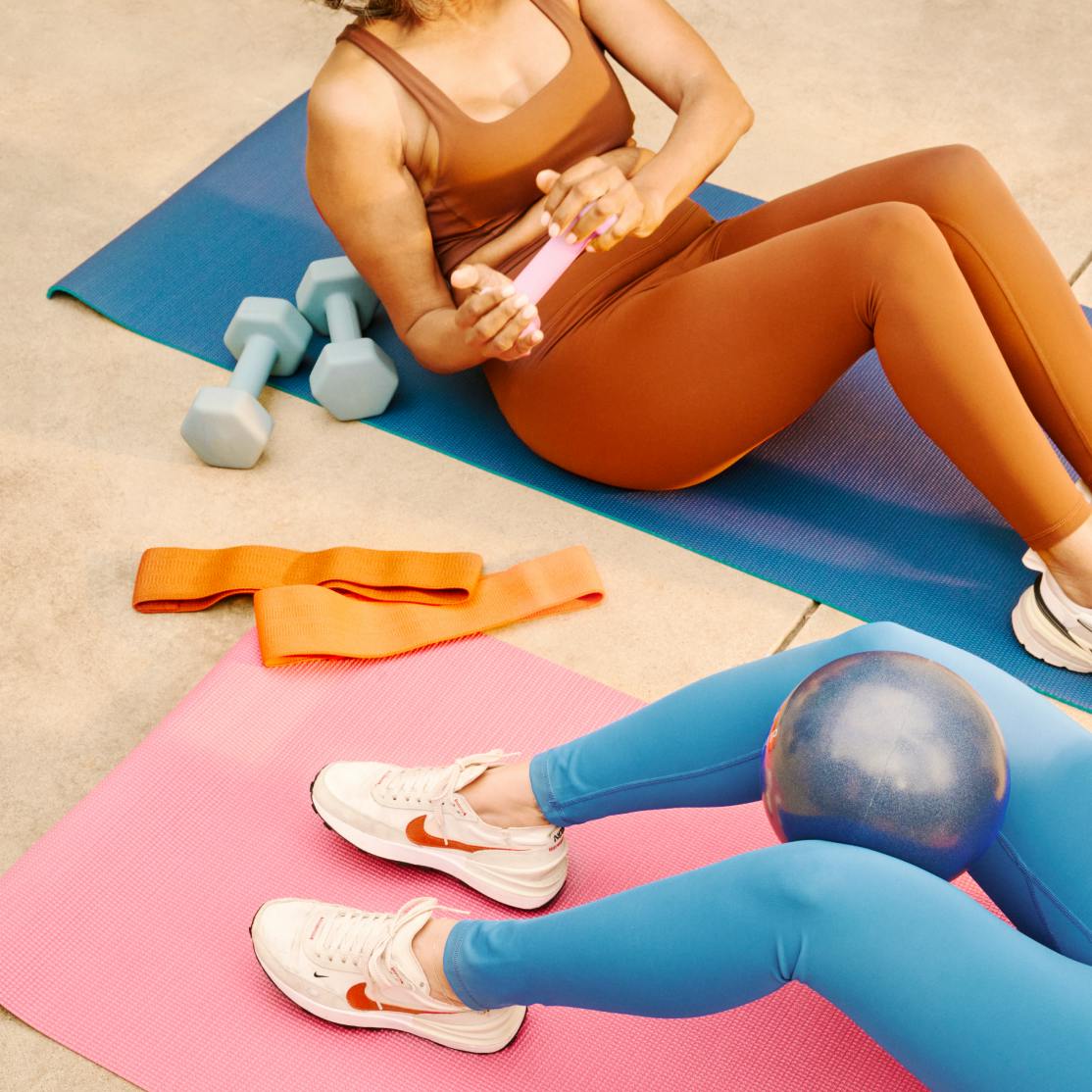Despite hormonal changes, women over 50 can—and should—build muscle. What you’ll need: a science-backed approach that combines twice-weekly resistance training, strategic protein intake, and proper recovery. Read on to learn about specific exercises that target functional movements, nutrition strategies to support muscle growth, supplement recommendations backed by research, and practical solutions to common challenges like joint pain and time constraints. Whether you're a fitness newcomer or looking to adapt your routine for your changing body, we’re here to provide the roadmap to gaining strength, improving metabolism, enhancing bone density, and maintaining independence as you age.
For nearly 20 years, I was the quintessential cardio queen. You could find me religiously pounding the pavement or in a cycling class, convinced that sweating through an hour of cardio was the only way. Lifting weights? Boring! Too hard! Not for me, thank you very much.
Then, in my mid-to-late 40s, something changed. Despite maintaining my cardio routine, I noticed clothes fitting differently. Tasks that used to be simple, like carrying groceries, resulted in elbow tendonitis that plagued me for months. My physical therapist’s advice was startlingly simple: "You need to lift weights." I reluctantly agreed to try, certain I'd hate it and equally certain it wouldn't make much difference. I couldn't have been more wrong.
Within just a few months of twice-weekly strength training, the changes were undeniable. Not only could I feel new strength emerging, but I also noticed definition in my arms and legs for the first time in years as well as more energy.
Now, a few years later, I understand that strength training was exactly the antidote I needed for the cascade of changes that happen around menopause—the slowing metabolism, the muscle loss, the bone density concerns, the shifting body composition. What began as reluctant compliance with doctor's orders has become my most powerful tool for aging with strength, mobility, and confidence.
The truth is, your body remains remarkably adaptable even after 50. If you've found everyday tasks becoming more challenging—if that gallon of milk suddenly feels as heavy as a bowling ball—you're experiencing what happens when we lose muscle mass. It's a silent process that often goes unnoticed until it affects daily activities. But with the right combination of resistance training, strategic nutrition, and proper recovery, you can not only preserve muscle but build new tissue that improves metabolism, strengthens bones, enhances balance, and maintains independence.
If you're where I was—skeptical, intimidated, or just unsure where to start—this guide is for you. Let me show you what I wish I'd known sooner about building muscle after 50, providing a science-backed roadmap to help you create a strong, functional body that supports an active, vibrant life for decades to come.
Understanding Muscle Loss After 50
Here’s the hard truth: After 50, women face a perfect storm of physiological changes that impact muscle mass.
During perimenopause and menopause, women experience a significant reduction in estrogen, which plays a crucial role in maintaining muscle mass. Research shows that during the menopausal transition, lean body mass decreases by about 0.5% annually, while fat mass increases by approximately 1.7% per year. This isn't just about appearance—it's about functionality, independence, and long-term health.
The technical term for this age-related muscle loss is sarcopenia, and it doesn't play fair. Without intervention, this loss accelerates, potentially affecting your ability to perform everyday activities, maintain metabolism, and preserve bone health.
But here's the empowering news: You can fight back against these changes. Research shows that women of all ages—yes, even in their 60s, 70s, 80s, and beyond—can build muscle with the right approach.
Benefits of Building Muscle After 50
Before we dive into the "how," let's talk about the "why." Building muscle after 50 isn't just about looking toned (though that's a lovely bonus!). The benefits extend to nearly every aspect of your health:
- Metabolic Magic: Muscle tissue burns more calories at rest than fat tissue does. More muscle means a higher resting metabolic rate, which helps manage weight. Research shows that adding just 3 pounds of muscle can increase your resting metabolic rate by approximately 7%. That's like having a tiny workout happening inside you 24/7, even when you're binge-watching your favorite shows.
- Bone-Building Benefits: Strength training helps preserve bone mineral density, reducing osteoporosis risk. When you strengthen your muscles, you're simultaneously strengthening the bones they're attached to. Studies show that women who perform regular resistance training can reduce bone loss and even increase bone density by 1-3% per year.
- Balance and Stability Support: Stronger muscles, particularly in your core and legs, improve balance and reduce fall risk—a major concern as we age. Research has found that strength training can reduce fall risk by up to 40% in older adults.
- Blood Sugar Control: Muscle tissue helps regulate blood glucose, improving insulin sensitivity and potentially reducing Type 2 diabetes risk. A study in the Journal of the American Medical Association found that women who performed strength training for at least 120 minutes per week had a 35% lower risk of developing Type 2 diabetes compared to women who didn't strength train. Your muscles are basically tiny sugar managers.
- Heart Health: Women who perform moderate-intensity exercise five times a week can reduce their risk of premature death by 24%. Research in the Journal of the American College of Cardiology found that women who incorporated muscle strengthening into their workouts had a 30% reduction in cardiovascular mortality
- Mood Improvement: Regular strength training releases endorphins that combat stress, anxiety, and depression—common mood challenges during the menopausal transition. A meta-analysis of 33 clinical trials found that resistance training significantly reduced depressive symptoms among adults.
- Enhanced Independence: Maintaining strength means maintaining your ability to carry groceries, play with grandchildren, garden, travel, and enjoy life on your terms. Research shows that muscle strength is one of the strongest predictors of maintaining physical independence later in life. Because the only thing better than being a strong woman is being a strong, independent woman.
The Science of Strength
Research consistently shows that the best approach for improving physical function and avoiding disability combines walking with resistance training. This combination addresses both cardiovascular health and muscle preservation. In a landmark study by the National Institute on Aging, researchers found that this combined approach not only improved physical function in older adults but also significantly reduced the risk of major mobility disability.
For women specifically, strength training has been shown to offset many of menopause's effects on the body.
What makes resistance training so effective? When you challenge your muscles with weights, bands, or even your body weight, you create microscopic tears in muscle fibers. During recovery, your body repairs these tears, making the muscles stronger and larger—a process called hypertrophy. Research in the Journal of Applied Physiology confirms that this adaptive response remains robust even in women over 60, though it may require more consistent training and adequate protein intake.
The Best Strength Exercises for Women Over 50
The most effective strength-training moves for women over 50 target functional movements that support everyday activities. These include:
Squats (supports the ability to sit and stand)
- Stand with feet shoulder-width apart
- Lower your body as if sitting in a chair
- Keep knees behind toes
- Press through heels to return to standing
Modified Push-ups (upper body strength)
- Begin with wall push-ups if needed, progressing to knee push-ups
- Keep your core engaged
- Lower and lift with control
Seated Rows (back strength, posture)
- Using a resistance band anchored around a sturdy object
- Sit tall, extend arms, and pull band toward your ribcage
- Squeeze shoulder blades together
Overhead Press (shoulder strength)
- Hold light weights in each hand at shoulder height
- Press weights overhead without arching your back
- Lower with control
Lunges (lower body stability)
- Step forward with one foot
- Lower your body until both knees form 90-degree angles
- Push through front heel to return to standing
Planks (core strength)
- Begin with knee planks if needed
- Hold position with engaged core for 15-30 seconds
- Build duration gradually
Hip Bridges (glute strength, pelvic stability)
- Lie on back with knees bent, feet flat
- Lift hips toward ceiling, creating a straight line from knees to shoulders
- Lower with control
Pro Tips for Safe and Effective Strength Training
- Start where you are: If you're new to strength training, begin with bodyweight exercises or light weights.The only person you're competing with is yesterday's version of yourself.
- Focus on form over weight: Proper technique prevents injury and ensures you're working the intended muscles
- Progress gradually: Increase weights by 5-10% when exercises become easy (ie, you can finish all reps without feeling fatigued)
- Include a warm-up and cool-down: 5-10 minutes of light cardio and dynamic stretching before, static stretching after
- Listen to your body: Muscle fatigue is expected; pain is not. If you find a particular move painful, modify or scale back until you build more strength.
Remember: Consistency trumps intensity, especially when you're starting out. It's better to do moderate workouts regularly than intense sessions sporadically followed by two weeks on the couch wondering why everything hurts.
Essential Strategies For Building Muscle
When it comes to building muscle after 50, not all exercise is created equal. While walking, swimming, and other cardio activities offer tremendous health benefits, resistance training is the gold standard for muscle growth.
Essential Strategy #1: Build Your Weekly Muscle-Building Workout Plan

For optimal results, aim for:
- 2-3 strength training sessions per week, with at least one rest day between sessions
- A mix of exercises that target all major upper and lower body muscle groups
- 2-3 sets of each exercise
- 8-12 reps per set
Don't worry—this doesn't mean spending hours in the gym. A focused 30-minute session (with the moves suggested above) is plenty, especially when you're starting out.
Essential Strategy #2: Protein Power for Your Muscles
While exercise provides the stimulus for muscle growth, nutrition supplies the building materials. Protein plays a starring role in this process.
Why Protein Needs Increase After 50
As we age, our bodies become less efficient at processing protein, a phenomenon called anabolic resistance. This means women over 50 need more protein than their younger counterparts to achieve the same muscle-building results. Research suggests that optimal protein intake for older adults ranges from 1.0 to 1.2 grams per kilogram of body weight daily—higher than the standard recommendation of 0.8 grams. Some advise even higher intakes, with recent findings indicating that 1.6 grams per kilogram (or 0.73 grams per pound) may be optimal for older adults looking to maintain or build muscle. For a 150-pound woman, that's about 68-110 grams of protein daily.
Timing Matters: The Protein Distribution Strategy
Research indicates that spreading protein intake evenly throughout the day is more effective than consuming most of it at dinner (which is common in American diets). Aim for 25-30 grams of protein at each meal.
This approach keeps muscle protein synthesis (the process of building new muscle) activated throughout the day, rather than just once. A study in the Journal of Nutrition found that older adults who evenly distributed their protein intake across three meals had 25% higher muscle protein synthesis rates compared to those who consumed the same amount of protein primarily at dinner.
Top Protein Sources for Women Over 50
Focus on high-quality, complete proteins that provide all essential amino acids:
- Lean meats: Chicken, turkey, lean beef (3 oz = ~25g protein)
- Fish: Salmon, tuna, trout (3 oz = ~22g protein)
- Eggs: Whole or whites (1 whole egg = 6g protein)
- Dairy: Greek yogurt, cottage cheese, milk (1 cup Greek yogurt = ~20g protein)
- Plant proteins: Tofu, tempeh, legumes, quinoa (1 cup lentils = ~18g protein)
For vegetarians and vegans, combining different plant proteins ensures you get all essential amino acids.
Essential Strategy #3: Recovery and Rest
In our achievement-oriented culture, rest often gets shortchanged. However, for women over 50, recovery isn't optional—it's essential for muscle growth.
Sleep: Your Muscle-Building Ally
During deep sleep, your body releases growth hormone, which repairs and builds muscle tissue. Aim for 7-8 quality hours nightly. If hot flashes or night sweats interfere with sleep (turning your bed into an impromptu sauna at 3 AM), strategies like keeping your bedroom cool, using moisture-wicking sheets, and maintaining a consistent sleep schedule can help.
Active Recovery Days
Between strength sessions, incorporate active recovery like walking, swimming, or gentle yoga. These activities promote blood flow to muscles without causing additional breakdown, accelerating the recovery process.
Listen to Your Body
After 50, you might need more recovery time between workouts—and that's perfectly fine. Quality trumps quantity every time. If muscles are still sore from your previous workout, give them another day to recover before training that same muscle group again.
Tips for Maximizing Muscle Gain
Building muscle after 50 isn't just about what you do in the gym—it's about creating a lifestyle that supports muscle growth and maintenance. Here are key strategies backed by research:
- Stay consistent: Steady efforts compound dramatically over time.
- Don’t get dehydrated: Water plays a crucial role in muscle function and recovery. Research in the journal Sports Medicine found that even mild dehydration (a loss of just 2% of body weight) reduced exercise performance by up to 10% and increased perceived exertion. For women over 50, proper hydration becomes even more important as the sensation of thirst often diminishes with age.
- Track Your Progress: Keeping a simple training log helps you see improvements that might otherwise go unnoticed. Document weights lifted, repetitions completed, and how you feel during and after workouts. Every few weeks, take measurements or photos to visualize changes that the scale won't show (remember, muscle is denser than fat—you might be getting stronger and more toned without losing weight).
Challenges and Solutions
Women over 50 face unique challenges when building muscle, but each obstacle has practical solutions backed by science.
Challenge: Joint Pain and Discomfort
Many women experience increased joint discomfort with age. In fact, according to a 2020 meta-analysis of 16 studies, 71% of women in perimenopause reported experiencing musculoskeletal pain. This can of course make traditional strength exercises more challenging.
Solutions:
- Water-based resistance training: Research has found that aquatic resistance training can reduce joint pain and discomfort in women with osteoarthritis and improve quality of life.
- Modify movement ranges: Working within a pain-free range of motion still stimulates muscle growth. Even partial range-of-motion exercises can effectively build muscle when performed with appropriate resistance.
- Prioritize proper form: Using the correct exercise form when you work out can reduce joint stress to keep you from getting injured.
Challenge: Time Constraints
Balancing work, family responsibilities, and possibly caregiving can make regular exercise seem impossible.
Solutions:
- Embrace shorter, focused workouts: Research in the journal Sports Medicine found that three 10-minute strength sessions produced similar results to one 30-minute session in older adults.
- Incorporate “functional movement” into daily activities: Accumulating resistance training throughout the day (like deliberate squats while unloading groceries or counter push-ups while waiting for coffee) also counts.
- Schedule exercise like any other appointment: Once it’s carved out, and penciled in, on your calendar, you’re less likely to skip it.
Challenge: Motivation and Consistency
Starting a strength training program is one thing; maintaining it is another. Many women struggle with motivation, especially when results aren't immediately visible.
Solutions:
- Find a workout buddy or community: The accountability of having someone to exercise with – or someone who is waiting for you to go for that walk–can keep you on schedule. Plus, having someone to laugh with when you both can't get up off the floor after core work is priceless.
- Focus on how you feel, not just how you look: Consider increased energy, better sleep, and improved mood as exercise benefits, not just appearance-based results.
- Start with manageable goals: Set moderate, achievable goals, like feeling less winded walking up a flight of stairs, so that you stick with your program for the long-term.
Supplements That Support Muscle Growth After 50
While whole foods (like the ones mentioned above) should form the foundation of your nutrition plan, certain supplements can help fill gaps or provide targeted support.
Evidence-Based Supplements for Muscle Strength
- Protein Powder: Convenient for meeting increased protein needs. Options include whey (fastest absorption), casein (slow-release), and plant-based varieties. Some research has found whey protein to be particularly effective for building muscle in older adults, more so than plant-based proteins, though both can be beneficial.
- Creatine: Research shows creatine can help counteract menopause-related declines in muscle, bone, and strength by reducing inflammation and oxidative stress. Women's muscle creatine stores tend to be 70-80% lower than men's, and these stores drop further during hormone-related changes like menopause. In one study, older women supplementing with creatine reported an average 57% improvement in their strength compared to 36% among those not using creatine. The standard dose is 3-5 grams daily. And no, it won't make you look like a bodybuilder.
- Vitamin D3: Vitamin D plays a critical role in maintaining bone density, muscle function, and overall health. A clinical trial from Brazil found that vitamin D supplementation significantly increased muscle strength and reduced sarcopenia in postmenopausal women, even 12+ years after menopause. Have your levels checked and supplement if necessary, typically 1,000-2,000 IU daily. Consider it your personal sunshine in a bottle, especially useful if you live somewhere that sees more clouds than clear skies.
- Omega-3 Fatty Acids: Recent research suggests omega-3 fatty acids assist at the molecular level in muscle protein synthesis, with some studies showing that increases in muscle mass were more pronounced in females performing resistance exercise when supplementing with omega-3s. Aim for 1-2 grams daily from fish oil or algae-based supplements (for vegetarians).
- Calcium: Supports bone health alongside muscle function. The National Osteoporosis Foundation recommends 1,200 mg daily for women over 50 from combined food and supplement sources.
- Collagen: Collagen supplements support muscle growth indirectly by strengthening connective tissues, improving joint health, and aiding recovery, which helps you train more effectively. While not a complete protein, collagen can complement resistance training, but it shouldn’t replace high-quality protein sources.
Before taking any supplements, it's always important to check in with a healthcare provider, like a Midi clinician, to make sure they're right for you.
Common Myths About Women and Muscle Building
"I don't want to get bulky."
This is perhaps the most common concern among women considering strength training. Rest assured: women typically lack the testosterone levels required for significant bulking. Getting "bulky" requires dedicated effort, specific nutrition, and often genetic predisposition. It's like worrying that driving a car will accidentally turn you into a NASCAR racer—not going to happen without intentional, specialized training. Instead, strength training creates a toned, defined appearance while improving functional strength.
"The gym intimidates me."
You don't need a gym membership to build muscle. Resistance bands, dumbbells, or even household items (water bottles, canned goods) can provide effective resistance. Many excellent strength-training programs are designed for home use with minimal equipment. Remember, Jane Fonda revolutionized fitness with nothing but a leotard and a living room—you can too, minus the leg warmers (unless you're feeling nostalgic).
"I have joint pain."
Work with your healthcare provider to determine safe exercises for your specific situation. Water-based resistance training can be gentle on joints while still building muscle. Focusing on proper form and starting with lighter weights can also minimize joint stress.
"I don't have time."
Effective strength training can be accomplished in just 20-30 minutes, 2-3 times weekly. Consider breaking sessions into smaller chunks if needed—even 10-minute sessions add up. It's all about priorities, and you deserve to be one of yours.
Key Takeaways
- Building muscle after 50 isn't just possible—it's one of the most powerful steps you can take toward a healthy, vibrant future. It's also never too late to get stronger.
- By combining targeted strength training, strategic protein intake, proper recovery, and select supplements, you can preserve and build muscle at any age.
- Consistency matters more than intensity. Progress happens gradually—celebrate small victories.
- The strength you build today becomes the independence, vitality, and confidence you carry into tomorrow. Your future self will thank you for every rep.
If you’re in perimenopause or menopause and want guidance from clinicians who specialize in women’s midlife health, book a virtual visit with Midi today.
Hormonal change is at the root of dozens of symptoms women experience in the years before and after their period stops.
Our trained menopause specialists can help you connect the dots to guide you towards safe, effective solutions.
Whether you need personalized guidance or a prescription routine to tackle symptoms—including brain fog, hot flashes, sleep trouble, mood swings, and weight gain—we’ve got you covered. Learn more here.
Midi’s mission is to revolutionize healthcare for women at midlife, wherever they live and whatever their health story. We believe that starts with education, to help all of us understand our always-changing bodies and health needs. Our core values guide everything we do, including standards that ensure the quality and trustworthiness of our content and editorial processes. We’re committed to providing information that is up-to-date, accurate, and relies on evidence-based research and peer-reviewed journals. For more details on our editorial process, see here.
 Liz Krieger
Liz Krieger





